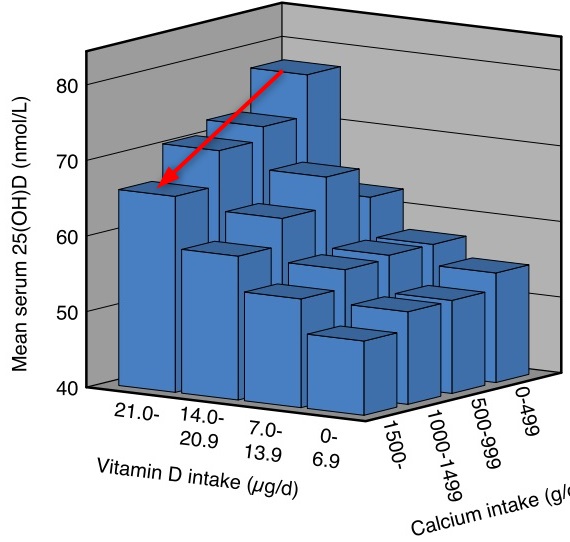Increased Calcium decreases Vitamin D in males
Increased calcium intake is associated lower serum 25-hydroxyvitamin D levels in subjects with adequate vitamin D intake: a population-based observational study
BMC Nutrition v 6, # 49 (2020) Nov 2, DOI https://doi.org/10.1186/s40795-020-00381-4
Rolf Jorde & Guri Grimnes
Males red arrow is > 840 IU of vitamin D

📄 Download the PDF from Vitamin D Life
Background
There are indications that an increased intake of calcium has a vitamin D sparing effect, which might be explained by a decreased catabolism of 25-hydroxyvitamin D (25(OH)D). However, there are only a few studies where this has been examined.
Method
In the seventh survey of the Tromsø study, serum 25(OH)D and parathyroid hormone were measured, and questionnaires on calcium and vitamin D intakes filled in.
Results
There were significant interactions between sex, calcium and vitamin D intakes regarding serum 25(OH)D level. The analyses were therefore done stratified. In males there was, regardless of vitamin D intake, a significant decrease in serum 25(OH)D with increasing calcium intake. The difference in serum 25(OH)D between those with the highest and lowest calcium intakes was approximately 10%. In the females, there was in subjects with low vitamin D intake (< 7 μg/d) a significant increase in serum 25(OH)D with increasing calcium intake, which could not be explained by secondary hyperparathyroidism. In females with higher vitamin D intakes, increasing calcium intake was associated with lower serum 25(OH)D levels.
Conclusions
There is, at least in subjects with an adequate vitamin D intake, a negative association between calcium intake and serum 25(OH)D.
